Dr. Billy Mag Fhloinn
I had been watching the Pallasboy project since its inception, and was extremely impressed not only by its achievements, but also at the attitude and outlook of its participants. Their willingness to embrace a creative approach to ancient objects is very compelling, and so I was both delighted and slightly daunted when approached to recreate replica artefacts for the second phase. I have about a decade’s worth of experience making replica bronzes using prehistoric methods and tools, but this was quite an involved task, and the resultant objects were not ornamental, but needed to function well under demanding conditions.
The interaction between art and archaeology is one that I have been interested in for many years. I studied archaeology in UCD, but only after flirting with an art career in Limerick School of Art and Design for a year. I left art college, but never really abandoned the idea that art had some way of informing archaeology. This manifested in many ways throughout my college years, and I spent very little time in trenches, but a lot of time making replicas of things from the past, learning not only how they were manufactured, but also how they worked after they were made.
I discovered Umha Aois in 2004, a collaborative and ongoing experimental project formed of artists & archaeologists, who research and practice prehistoric metalworking techniques. They hold a major annual symposium, as well as other minor events during the year, which sees them working together to recreate replica objects and new art pieces in simple charcoal-fuelled pit furnaces. What is immediately obvious when attending their symposia is the depth of knowledge and ability brought to bear by the members, who include sculptors, jewellers, stone carvers, ceramic artists, archaeologists and engineers. It is a fertile learning environment, and practical skill combines with creative zeal to great effect.
It was in this context that I learned how to make objects from bronze using stone moulds, clay press moulds and lost wax modelling. At first I had a lot of direct tutelage, but soon was allowed the freedom to do my own experiments and make my own art. The process can be rich and varied, but what quickly became apparent is how much more there is to casting than the straightforward craft elements. The physicality of the workspace is striking, and it is not difficult to imagine that symbolism must have been inherent in furnaces, moulds and crucibles. Casting is a very visually arresting process, and is one of the closest things to alchemy one can experience.
(Casting photos courtesy of Billy Mag Fhloinn)
The creativity of bronze workers also manifests in lots of other ways, and the embodied skill of artists and artisans can be seen in how the furnace pits are made and laid out, how the necessary equipment is made, and how the many small problems encountered are solved in ingenious manner. Another, far less tangible element to the process is the social dynamic. Casting often takes place after dark, and the furnace acts as a natural hearth around which conversation, joking and song takes place. The work is interwoven with play, and the way people in the past might have done the same is a popular topic of discussion. Other aspects include little rituals, customs and even superstitions that are constantly creeping into and around the periphery of the activity. The process becomes imbued with a significance that, while sometimes fanciful, offers intriguing possibilities as to what people in the past might have thought about casting, and indeed, the cast objects themselves.
I had plenty of opportunity to make the tools for the Pallasboy Project, as I spent two periods over the summer of 2016 making replica artefacts. The first was part of the Irish Field School of Prehistoric Archaeology’s summer programme, where Ros Ó Maoldúin and I took ten students to Craggaunowen in Co. Clare for a week of replica artefact making. Many of these students had spent the previous month excavating wedge tombs in the Burren, and the course offered them an opportunity to engage with artefacts and processes in a way that opened them to new insights into metallurgy, and its significance in Chalcolithic society. It also gave me a chance to make axes, and I used the opportunity to cast some palstaves using clay press moulds, and one flat axe in an open stone mould. One attempt at a late bronze age socketed axe was disastrously unsuccessful, and served to remind me how much I still have to learn about prehistoric techniques.
Later on in the summer I attended the Umha Aois 2016 annual symposium, which took place this year as part of the Skibbereeen Arts Festival. This is something of an annual pilgrimage for me, for many of the reasons outlined above, and I was given valuable assistance in making many of the tools. Special mention must be made of Holger Lonze, who lent me two rubber moulds taken from original Bronze Age artefacts. I made wax copies from these, and used the lost wax technique to replicate two identical flat axes and one socketed axe. One of the two flat axes was eventually mounted as an adze, while the other was hafted as an axe, to demonstrate the possible diversity of use of these tools.
Having spent these two extremely enjoyable stints by the fire, and far away from the real world, I came home with a nice hoard of bronzes, waiting to be cleaned and hafted. It is at this stage that one really appreciates the skill of the original smiths. Cleaning and polishing bronze using modern tools is an arduous process, but must have been much more so in the past. I also imagine that they must have been very exacting in trying to achieve as fine a finish as possible during the casting process, as a rough surface, or one with pits, excess sprues or other flaws would have required a lot of finishing in order to produce a presentable object. A good mould, well poured, saves a lot of time on the other side.
Another part of the process involves putting a good cutting edge on the tools. Bronze straight from the mould is quite soft, due to its being annealed by the casting process. Work hardening was required in order to make the cutting edge tougher, and this is achieved by hammering the bronze while it is at room temperature. Heating and quickly quenching steel makes it tough, but has the exact opposite effect on copper and its alloys. By hammering the metal, the crystalline lattice of its structure is deformed, and it becomes a lot tougher. It is important not to be too vigorous, however, as excessive work hardening will crack the metal. A balance must be struck, therefore, between sufficiently hardening the metal, and not damaging the cutting edge. Once the hammering was completed on all the tools, they had to be honed to a final sharpness. This is a skill required of anyone using bronze tools, as they need more regular sharpening than steel. It is not surprising, therefore, that whetstones are a relatively common find on archaeological sites.
Once the objects had been cleaned up, the excess bronze removed and retained for recycling, and the edges sharpened, the final stage was to make suitable handles. After I had consulted archaeological reports as to the most appropriate wood to use, Brian Mac Domhnaill from the Pallasboy Project delivered a selection of L-shaped ash handles to my workshop in west Kerry. We spent the bones of two days laying out the axeheads on their prospective mounts, carving them into shape, and cutting the correct notches in which the bronzes would be fixed. I then mixed a batch of adhesive, consisting of tree resin, beeswax and charcoal dust. The resultant glue was heated and dripped carefully into the wood, and the axeheads fitted before it set. Then we cut long strips of wet rawhide to bind the axes in place, and after it had dried and shrunk, it held a very firm grip on the assemblage. The final selection of tools included a flat axe and an adze, three palstaves of various sizes, two socketed axes, one socketed gouge and a trunnion chisel.
I was delighted to hear of the success of the subsequent workshop, whereby artists and craftspeople were invited to use the tools to directly engage with woodcarving, in a practical attempt to explore the anthropomorphic figures of late North European prehistory. They seem to have held up well, and in some instances even added something to the insight gained by the participants. Once again, art, craft and archaeology combine to give a deeper understanding of the past, and bring inspiration to the present. It was an honour to have played a part in this process.

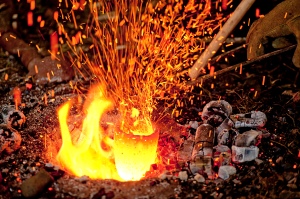
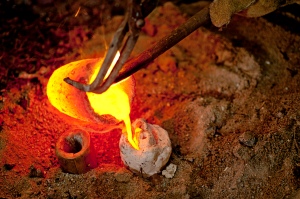
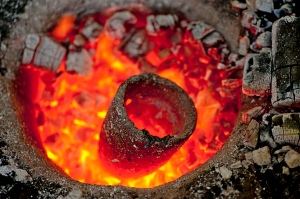
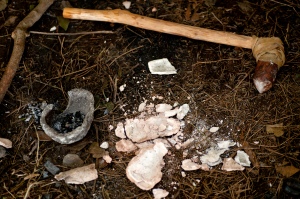
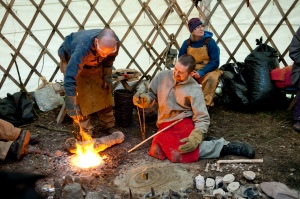
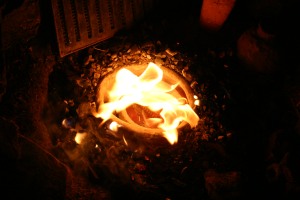
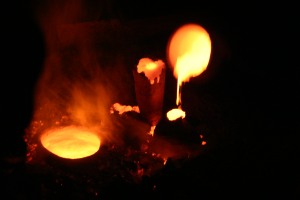
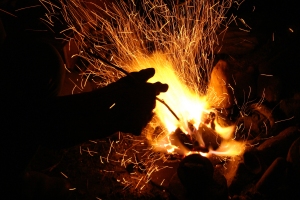


































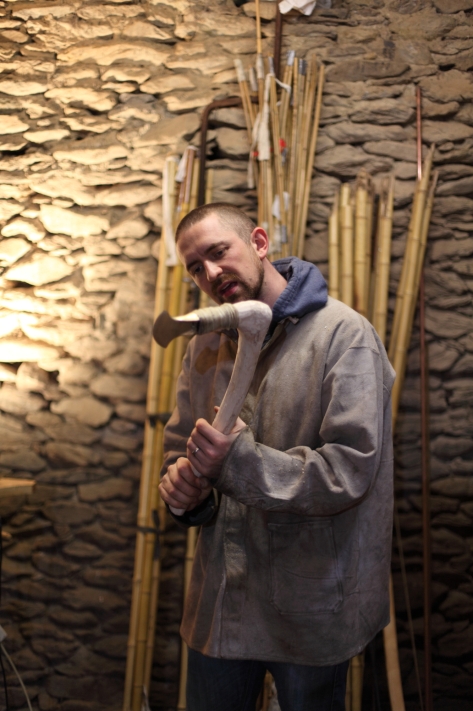
Thank you, Billy.
Good that they have historically accurate and functional(!) tools now.
LikeLiked by 1 person